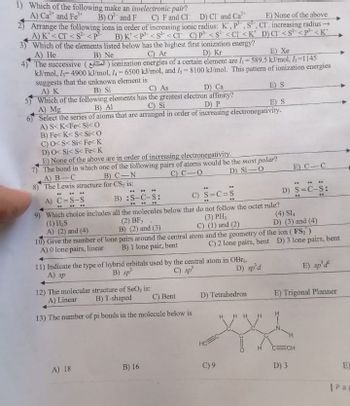
Chemistry: Principles and Practice
3rd Edition
ISBN: 9780534420123
Author: Daniel L. Reger, Scott R. Goode, David W. Ball, Edward Mercer
Publisher: Cengage Learning
expand_more
expand_more
format_list_bulleted
Concept explainers
Question
please solve only question 7

Transcribed Image Text:1) Which of the following make an isoelectronic pair?
A) Ca and Fe
B) O and F
C) F and CI D) Cl and Ca
2) Arrange the following ions in order of increasing ionic radius: K', P, S, CI. increasing radius →
E) None of the above
A) K'<CT <S² <P³
B) K<P <S² <CT C) P³¹ <S² <CI <K
3) Which of the elements listed below has the highest first ionization energy?
D) CI <S² <p³<K'
A) He
B) Ne
C) Ar
D) Kr
E) Xe
4)
The successive () ionization energies of a certain element are I₁=589.5 kJ/mol, ₂-1145
kJ/mol, I=4900 kJ/mol, 4-6500 kJ/mol, and Is-8100 kJ/mol. This pattern of ionization energies
suggests that the unknown element is
A) K
B) Si
C) As
D) Ca
E) S
5) Which of the following elements has the greatest electron affinity?
A) Mg
B) Al
C) Si
D) P
E) S
6)
Select the series of atoms that are arranged in order of increasing electronegativity.
A) S< K<Fe< Si<0
B) Fe< K<S< Si<0
C) O<S< Si< Fe< K
D) O< Si<S< Fe< K
E) None of the above are in order of increasing electronegativity.
7) The bond in which one of the following pairs of atoms would be the most polar?
A) B-C
B) C-N
C) CO
D) Si-O
8) The Lewis structure for CS, is:
...
" **
**
"
**
A) C=S-S
B) :S-C-S:
C)
S=C=S
..
.. ..
**
..
9) Which choice includes
all the molecules below that do not follow the octet rule?
(1) H₂S
(2) BF,
(3) PH,
(4) SI
D) (3) and (4)
A) (2) and (4)
B) (2) and (3)
C) (1) and (2)
10) Give the number of lone pairs around the central atom and the geometry of the ion (FS₂)
C) 2 lone pairs, bent D) 3 lone pairs, bent
A) 0 lone pairs, linear B) 1 lone pair, bent
11) Indicate the type of hybrid orbitals used by the central atom in OBr
A) sp
B) sp
C) sp³
D) sp'd
E) sp'd
12) The molecular structure of SeO₂ is:
A) Linear
B) T-shaped
C) Bent
D) Tetrahedron
E) Trigonal Planner
13) The number of pi bonds in the molecule below is
4 Η
ECH
A) 18
B) 16
HOC-
C) 9
E) C-C
**** ..
D) S=C-S:
D) 3
E)
| Pa
Expert Solution
This question has been solved!
Explore an expertly crafted, step-by-step solution for a thorough understanding of key concepts.
Step by stepSolved in 2 steps with 1 images

Knowledge Booster
Learn more about
Need a deep-dive on the concept behind this application? Look no further. Learn more about this topic, chemistry and related others by exploring similar questions and additional content below.Similar questions
- What neutral atoms are isoelectronic with the following ions? (a) Pb4+ (b) Br (c) S2 (d) Ni3+arrow_forwardWhich of these isoelectronic ions, Ba2+, Cs+, or La3+, is (a) the largest? (b) the smallest? Explain your reasoning.arrow_forwardWhich of the following statements is(are) true? a. F has a larger first ionization energy than does Li. b. Cations are larger than their parent atoms. c. The removal of the first electron from a lithium atom (electron configuration is ls2 2s1 ) is exothermic-that is, removing this electorn gives off energy. d. The He atom is larger than the H+ ion. e. The Al atorn is smaller than the Li atom.arrow_forward
- Two elements are in the same group, one following the other. One is a metalloid; the other is a metal. Both form oxides of the formula RO2. The first is acidic; the next is amphoteric. Identify the two elements.arrow_forwardFluoride ion, F, has no unpaired electrons. Vanadium forms four binary fluoridesVF2, VF3, VF4, and VF5. Assume that all four are ionic compounds. (a) Which fluoride is diamagnetic? (b) Which fluoride has the greatest attraction to a magnetic field? (c) Which fluoride has two unpaired electrons per vanadium?arrow_forwardFor each of the following pairs of atoms or ions, state which you expect to have the larger radius. (a) Na or K (b) Cs or Cs+ (c) Rb+ or Kr (d) K or Ca (e) Cl or Ararrow_forward
arrow_back_ios
arrow_forward_ios
Recommended textbooks for you
 Chemistry: Principles and PracticeChemistryISBN:9780534420123Author:Daniel L. Reger, Scott R. Goode, David W. Ball, Edward MercerPublisher:Cengage Learning
Chemistry: Principles and PracticeChemistryISBN:9780534420123Author:Daniel L. Reger, Scott R. Goode, David W. Ball, Edward MercerPublisher:Cengage Learning Chemistry: The Molecular ScienceChemistryISBN:9781285199047Author:John W. Moore, Conrad L. StanitskiPublisher:Cengage Learning
Chemistry: The Molecular ScienceChemistryISBN:9781285199047Author:John W. Moore, Conrad L. StanitskiPublisher:Cengage Learning General Chemistry - Standalone book (MindTap Cour...ChemistryISBN:9781305580343Author:Steven D. Gammon, Ebbing, Darrell Ebbing, Steven D., Darrell; Gammon, Darrell Ebbing; Steven D. Gammon, Darrell D.; Gammon, Ebbing; Steven D. Gammon; DarrellPublisher:Cengage Learning
General Chemistry - Standalone book (MindTap Cour...ChemistryISBN:9781305580343Author:Steven D. Gammon, Ebbing, Darrell Ebbing, Steven D., Darrell; Gammon, Darrell Ebbing; Steven D. Gammon, Darrell D.; Gammon, Ebbing; Steven D. Gammon; DarrellPublisher:Cengage Learning ChemistryChemistryISBN:9781305957404Author:Steven S. Zumdahl, Susan A. Zumdahl, Donald J. DeCostePublisher:Cengage Learning
ChemistryChemistryISBN:9781305957404Author:Steven S. Zumdahl, Susan A. Zumdahl, Donald J. DeCostePublisher:Cengage Learning Chemistry: An Atoms First ApproachChemistryISBN:9781305079243Author:Steven S. Zumdahl, Susan A. ZumdahlPublisher:Cengage Learning
Chemistry: An Atoms First ApproachChemistryISBN:9781305079243Author:Steven S. Zumdahl, Susan A. ZumdahlPublisher:Cengage Learning

Chemistry: Principles and Practice
Chemistry
ISBN:9780534420123
Author:Daniel L. Reger, Scott R. Goode, David W. Ball, Edward Mercer
Publisher:Cengage Learning

Chemistry: The Molecular Science
Chemistry
ISBN:9781285199047
Author:John W. Moore, Conrad L. Stanitski
Publisher:Cengage Learning

General Chemistry - Standalone book (MindTap Cour...
Chemistry
ISBN:9781305580343
Author:Steven D. Gammon, Ebbing, Darrell Ebbing, Steven D., Darrell; Gammon, Darrell Ebbing; Steven D. Gammon, Darrell D.; Gammon, Ebbing; Steven D. Gammon; Darrell
Publisher:Cengage Learning

Chemistry
Chemistry
ISBN:9781305957404
Author:Steven S. Zumdahl, Susan A. Zumdahl, Donald J. DeCoste
Publisher:Cengage Learning

Chemistry: An Atoms First Approach
Chemistry
ISBN:9781305079243
Author:Steven S. Zumdahl, Susan A. Zumdahl
Publisher:Cengage Learning
